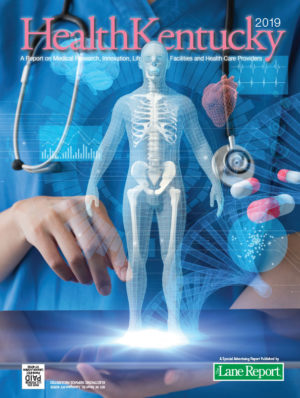
It happens to more than 250,000 Americans each year. Sometimes it begins with an odd sense of breathlessness or sweatiness not related to exertion. Many experience lightheadedness, chest pain or pressure, or a sense of dread.
Some or all of these symptoms can be signs of a type of particularly deadly heart attack called an acute ST elevation myocardial infarction, or STEMI heart attack.
“A STEMI heart attack begins with a sudden disruption of a mild cholesterol plaque in the wall of the coronary artery that supplies blood the heart. This leads to a buildup of a clot in an attempt to heal it. However, this clot formation results in total blockage of the artery,” said Dr. Vipul R. Panchal, interventional cardiologist with Norton Heart & Vascular Institute and medical director of interventional cardiology at Norton Brownsboro Hospital. “It usually occurs in an artery with only mild blockage initially and can occur suddenly without warning. Unfortunately, the rapid progression to total blockage leads to loss of blood supply to the heart. The heart muscle stops working within minutes of this and dies within minutes to hours unless the artery can be opened back up.”
With STEMI, time saved is life saved
Survival for more than a brief time with a completely blocked coronary artery is a risk, so it is critical to restore blood flow as quickly as possible in order to save a life. Diagnosing a STEMI heart attack can be done only with an electrocardiogram (EKG), which provides information about which part of the heart the blocked artery is supplying.
 In most situations, a patient having a STEMI heart attack needs to be treated immediately, and this usually involves an emergent cardiac catheterization to open the blocked artery or administer clot-busting medication directly to the artery.
In most situations, a patient having a STEMI heart attack needs to be treated immediately, and this usually involves an emergent cardiac catheterization to open the blocked artery or administer clot-busting medication directly to the artery.
While not every hospital in Kentucky has emergency cardiac catheterization capability, Norton Heart & Vascular Institute has established a regional STEMI Network to ensure patients from across the region have access to fast, expert, lifesaving care.
The network includes 12 community hospitals, emergency ground and air medical services, and three Norton Healthcare STEMI-ready hospitals. The goal of the network is to stabilize patients wherever they seek help and transport them to one of the receiving hospitals for cardiac catheterization to restore blood flow to the coronary artery as quickly as possible.
“We see dramatically different outcomes depending on the time it takes to restore blood flow,” Panchal said. “The American Heart Association has set a goal of 90 minutes or less from the time a patient first seeks help for a heart attack to when an intervention is performed to restore blood flow. In 2018, Norton Healthcare had a median time of 46 minutes for its care of STEMI heart attack patients due to ongoing team efforts.”
“Norton Healthcare and our network partners are dedicated to providing the best possible care for heart attack patients,” said Russell F. Cox, president and chief executive officer, Norton Healthcare. “The entire process is a well-oiled machine. Our teams practice with annual STEMI drills at each network location and the receiving Norton Healthcare facility to ensure the protocols are working.”
Nationally recognized teamwork
As a result of this team effort, Norton Healthcare received the American Heart Association 2019 Mission: Lifeline Regional Trailblazer Award. This is the first year the American Heart Association has recognized regional achievement as part of its awards program for quality patient care. Norton Healthcare was the only health care organization in Kentucky to receive this award.
“We are pleased to be recognized for our dedication and achievements in cardiac care through Mission: Lifeline and are honored to care for these patients who count on us to provide the advanced treatments they need,” Cox said.
Norton Heart & Vascular Institute STEMI Network members are:
• Breckinridge Health, Hardinsburg, Kentucky
• Carroll County Memorial Hospital, Carrollton, Kentucky
• Flaget Memorial Hospital, Bardstown, Kentucky
• Harrison County Hospital, Corydon, Indiana
• Jane Todd Crawford Hospital, Greensburg, Kentucky
• King’s Daughters Health, Madison, Indiana
• Louisville VA Medical Center
• Spring View Hospital, Lebanon, Kentucky
• Twin Lakes Regional Medical Center, Leitchfield, Kentucky
• Norton Women’s & Children’s Hospital, Louisville, Kentucky
• Clark Memorial Health, Jeffersonville, Indiana
• Scott Memorial Health, Scottsburg, Indiana
Norton Heart & Vascular Institute STEMI Network receiving hospitals are:
• Norton Audubon Hospital
• Norton Brownsboro Hospital
• Norton Hospital
All three receiving hospitals have been recognized by the American Heart Association with Mission: Lifeline STEMI Receiving Center Gold awards. The awards recognize efforts to meet or exceed specific criteria and standards of performance for quick and appropriate treatment through emergency procedures to re-establish blood flow to blocked arteries in heart attack patients. As a receiving center, patients come directly through the emergency department or are sent directly from a network facility.
Each network member collaborates with Norton Healthcare to expedite patient care when a STEMI heart attack is suspected and diagnosed. The hospital and emergency transport teams follow established protocols and closely coordinate with the interventional cardiology team at the receiving Norton Healthcare hospital.
“These regions receiving the Mission: Lifeline Regional Trailblazer award are pioneers in STEMI systems of care implementation and are leading the way in care coordination, use of evidence-based care guidelines and coming together to assure a high-quality functioning STEMI system of care,” said Alice K. Jacobs, M.D., professor of medicine, Boston University School of Medicine, and chair, GWTG-CAD Systems of Care Advisory Work Group.



















Add Comment